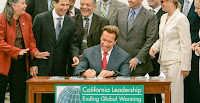Jeffery Greenblatt, an energy analyst at the Lawrence Berkeley National Laboratory, calculates that the policy that will have had the biggest effect on California's emissions by 2020 is actually a set of automotive standards that state Sen. Fran Pavley (D) passed in 2002. Known as the "clean cars law," A.B. 1493 dictates greenhouse gas standards for automobiles' tailpipe emissions and has been adopted on the federal level to set fuel economy standards for light-duty vehicles for model years 2009-25.
Without it, California's emissions would be 22 million to 30 million tons higher per year in 2020.
"I've determined it's one of the most powerful emissions-reducing policies," Greenblatt said. The RPS will be responsible for nearly as many reductions: 17 million tons per year in 2020. A 2006 law, S.B. 1368, that forbade utilities to sign new long-term contracts with out-of-state coal plants chips in another 8 million tons of reductions.
...
"A lot of our wealth is derived from IT. As a result, we can make a lot of money without producing much CO2," Greenblatt said. "That has nothing to do with climate legislation; that is just a fact of our modern economy."
As a result, the actual emissions backstop of A.B. 32 — the economy wide cap-and-trade system — has been responsible for a relatively small proportion of reductions. ARB itself anticipated in 2014 that the market would account for about 30 percent of reductions.
While no one has made any subsequent projections, Greenblatt's paper found that California would safely meet its 2020 target without it.
...
Economists expect cap and trade to play a much greater role in the years after 2020, presuming it makes it past current legal and political hurdles. While prices in the market are currently at the state-set minimum of around $12.70 per ton, the ratcheting down of the cap after 2020 could push them much higher.
"If cap and trade is still even permitted in that regime, I think that it could become extremely important in future years, and it may even play a role between now and 2020," Greenblatt said.
Read more at California: Taking the Economic Temperature 10 Years After A.B. 32

No comments:
Post a Comment